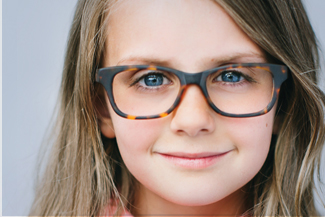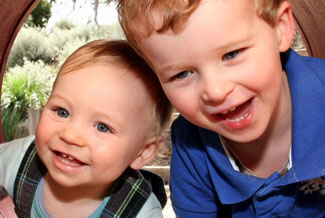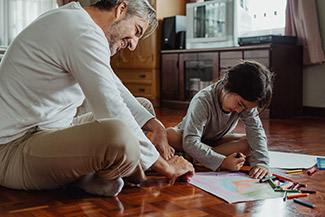What Is Vision Therapy?

20/20 vision is but ONE of over 17 important visual skills required to function efficiently to perform well in school or sports.
Children with reduced vision skills may work harder than their peers, yet be unable to achieve the results they seek. Their poor vision skills may also cause them to struggle to concentrate throughout the day.
Vision therapy is an evidence-based program to effectively strengthen the specific vision skills impacting your child and has been clinically proven to increase reading levels, enhance comprehension, maintain longer attention spans and even improve sports performance.
See a difference in your child’s school performance!
If your child has been diagnosed with a reading or learning difficulty or just not reaching their potential at school, or on the sports field, schedule an appointment with Dr. Marcy Rose in Westminster for a functional eye exam. Over 17 visual skills will be assessed, including eye tracking, reading fluency, focusing and depth perception.
Don’t let your child suffer in silence.
Vision therapy might just be the solution you have been seeking. Talk to us! We’ll help your child maximize their visual skills and resolve any underlying visual problems impacting your child.
How To Know If Your Child Needs Vision Therapy

If your child has any of the following, vision therapy can significantly change his or her life for the better.
- Skipping words or lines while reading
- Still not reading at grade level
- Confusing the letters b, d, p and q
- Rubbing eyes or closing one eye when reading or doing near work
- Holding books too closely or tilting head when reading
- Eyestrain or headaches with schoolwork or computer use
- Difficulty with reading comprehension
- Blurred or double vision when reading
- Avoiding homework
- Poor attention span
- Fidgeting and squirming in the chair
Help Your Child Reach Their Potential With Vision Therapy
At The Vision Therapy Center at North Park Vision Center we use a holistic approach to vision care. In addition to the usual eye exam, we also test the entire visual system (functional vision exam) to check that it has the developmental maturity, strength, and stamina to function optimally throughout the visual tasks performed on a daily basis.
Once we identify any vulnerable areas within the visual system that could interfere with reading and learning, we develop an effective vision therapy regimen made of individually-tailored eye exercises made to improve visual functions and retrain the brain to interpret visual input more accurately.
Contact The Vision Therapy Center at North Park Vision Center in Westminster today for a functional eye exam, or visit us with your concerns regarding your child’s vision, and we’ll be sure to find the best way to treat his or her visual problems.

Who Benefits from Vision Therapy?
Children and adults with visual challenges, such as:
Learning-related Vision Problems Vision Therapy can help children and adults who lack the necessary visual skills for effective reading, writing, and learning (i.e., eye movement and focusing skills, convergence, eye-hand activity, visual memory skills, etc.)
To learn more about vision-related learning problems, visit any of these web pages on
- Eye Tracking and Eye Teaming
- Success with Dyslexia
- Is it ADD/ADHD or is it a Vision Problem?
- 20/20 is Not Enough
- Vision and Learning — Links and Articles
Poor Binocular (Two-Eyed) Coordination
Vision Therapy helps individuals develop normal coordination and teamwork of the two eyes (binocular vision). When the two eyes fail to work together as an effective team, performance in many areas can suffer, such as reading, sports, depth perception, and eye contact, etc.
- Read about improved depth perception, eye tracking, and the elimination of double vision at Success with Visual Disabilties.
- To learn more about binocular (two-eyed) vision, visit web pages on What is 3D Stereo Vision or Depth Perception? and What is Convergence Insufficiency.
- Test your binocular vision with The Framing Game.
Visual Field Loss: What can be done?
Many stroke victims and individuals who suffered from other traumatic brain injuries report the experience of losing a portion (often up to half) of their field of vision. This is called ‘homonymous hemianopsia’ or ‘homonymous hemianopia’ and it occurs when an individual loses half of the field of view on the same side in both eyes. It occurs when as a result of the injury, the optic nerve fibers from each eye crossover each other as they continue carrying messages to the brain. The visual stimuli that we see to our right side travel from both eyes to the left side of the brain, while the visual images we see to the left side in each eye travel to the right side of the brain. Ultimately, when there is damage to the right side of the posterior portion of the brain, it can lead to a loss of the left field of view in both eyes. Likewise, damage to the left posterior brain can cause a loss of the right field of vision.
A homonymous hemianopsia can steal a patient’s independence. Patients report fear of running into objects, tripping, falling, knocking over drinks, and being startled by objects or people that suddenly appear out of nowhere. Patients may become so fearful of falling or running into objects that they may be unwilling to travel or shop without assistance. Panic attacks may even occur when in crowded stores because homonymous hemianopsia patients can easily become lost, feel disoriented and unable to navigate safely through the crowd. Patients often lose their place while reading. Some patients fearing both embarrassment and the danger of injury may continue to withdraw socially.
Our side vision allows us to distinguish approaching objects and people in an almost unconscious way. When a moving car passes in front of us, we are not alarmed, because we detected and sensed it was coming. When we lose part of our side vision from a hemianopsia, objects suddenly appear, often startling the patient. The patient may feel unsafe and even overwhelmed in crowded areas.
Patients may mistakenly believe that the loss of vision is just in one eye. They may report “my right eye has been bad since the stroke”, while actually the damage in the brain caused a loss in both eyes. Hemianopsia patients also routinely fail to fully report the degree of their visual disability. It is not uncommon that patients will deny the loss of visual field and report no problems, while caregivers observe them running into objects, tripping, and being startled.
Vision Therapy to develop scanning eye movements and new types of visual field expander lenses are helping patients return to a more normal life.

What Parents Are Saying About Us
Vision Therapy May Be What Your Child Needs | FAQ
Improve your child’s confidence levels with vision therapy!
Vision therapy is a non-surgical treatment program that is typically compared to physical therapy, but for the eyes and brain. Vision therapy uses exercises, lenses, specific instruments, and occlusions to enhance visual function.
All vision therapy programs are customized and can result in significant lasting improvements within a relatively short period of time. To learn more, contact us today and discover how we can help your child improve their performances both in school and on the sports field.














